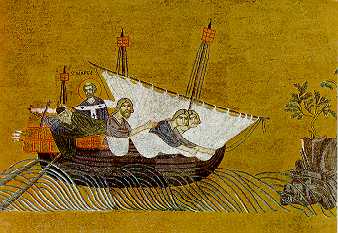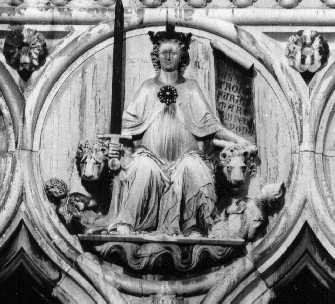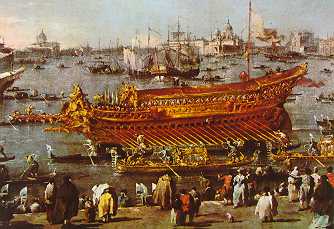
Although by the sixteenth century the calendar was filled with such feasts, two groups of days stand out as being of paramount importance in the Venetian year. The first is associated with Saint Mark, who since the early middle ages had replaced Saint Theodore as the principal protector-saint of the Republic.(8) For the Venetians the story of the translatio of the body of St. Mark was more than a legend; in the absence of classical origins for the city, it operated as an integral part of the ideological foundations of both church and state. The translatio is in turn just one stage of the Venetian adaption of the traditional pattern established by medieval hagiographers for the authentication of relics. A tripartite process, this consisted of a martyrdom (passio), the discovery of relics (inventio) and their transferral (translatio) to which a fourth element (dedicatio) could sometimes be added.

Translatio of St. Mark, mosaic (XIII century). Venice, St. Mark Basilica.
In the case of Mark both the inventio (by which the relics, supposedly transferred to the city in 827 and, having been subsequently lost miraculously revealed themselves in 1094), and the dedicatio of the present Basilica a short time afterwards, were both associated with dogal action. Hence, like the translatio itself, they were both politicised from an early date.(9) As the possessors of the Evangelists's body, the Venetians modelled their relationship to Mark on that of the popes to St. Peter. In Venetian eyes Venice was as autonomous as Rome, and the doge's authority, inherited from Mark, as absolute and independent as that of the occupant of the Chair of St. Peter. It is not surprising that the rituals which took place on St. Mark's feastday emphasised this bond between the doge and the idea of descending authority. The churches of the city bristled with paintings showing events from the life of the Evangelist, one of the scuole grandi was named after him, and no fewer than four major feastdays were dedicated to him. Indeed, by the Renaissance the symbol of the Lion of St. Mark had come to stand for Venice itself, and was extensively used throughout the city, the terraferma and the empire as an emblem of Venetian authority. Not surprisingly, texts in honour of Mark are common in the works of Venetian composers.
The second main patron-protector of Venice was the Virgin Mary who, like Mark, played an important role in Venetian state theology partly due to her long-standing association with the foundation and early history of the city itself. In the rhetoric of this central aspect of Venetian official historiography, the city was presented as a pure, uncorrupted virgin state, unwalled and yet unconquered for more than a thousand years, a city unviolated by outside forces. In this way, Marian devotion and the designation of Venice as a special protectorate of the Virgin completed the notion of uniqueness and perfection which lies at the heart of the 'Myth of Venice' and which had been so eloquently delineated by Petrarch in his famous description:
'The august city of Venice rejoices, the one home today of liberty, peace and justice, the one refuge of honourable men, the one port to which can repair the storm-tossed, tyrant-hounded craft of men who seek the good life. Venice-city rich in gold but richer in renown, mightier in works but mightier in virtue, founded on solid marble but established on the more sold foundations of civic concord, surrounded by the salty waves but secure through her saltier councils. (Petrarch: Epistolae seniles, iv, 3.)
A central figure in Venetian political iconography was Venetia herself, who since at least the middle of the fourteenth century had been represented as a modified figure of Justice, holding scales and sword and seated upon a Solomonic throne of lions. And since, according to official legend, the city had been founded on the feast of the Annunciation, the Origo Venetiarum, Venetia also assumed the attributes of the Virgin, in particular her purity and immortality.

Venetia - Giustizia. Venice, Palazzo Ducale.
Venice was not, of course, the only Italian state dedicated to the Madonna, but there Marian devotion was distinguished by a particularly complex and distinctive mixture of sacred and civic conceptions. On all the major feast-days of the Virgin the doge attended Mass at St. Mark's, and the Venetians celebrated the feasts of the Annunciation and the Assumption as great civic celebrations of the Republic. In all, a third of the major Marian feasts in the Venetian calendar had civic connotations. In addition to being constantly reminded of the local resonances of the cult of the Madonna through the annual liturgical cycle, the inhabitants of the city were everywhere confronted by Marian images. On the facade of St. Mark's itself, that most politically charged of all Venetian churches, reliefs of the Virgin and the Achangel Gabriel are accompanied by other protectors of the city, SS. George and Demetrius, and Hercules, the mythical tribal hero of the Venetii, who is represented twice. At a more general level, the figure of the Virgin as protectress occurs on dozens of canvasses executed for Venetian churches and othe buildings in the course of the Renaissance; for the citizens of the Republic her comforting image carried a quite precise political and civic message that was intimately connected to the origins, evolution and future of La Serenissima. By the sixteenth century the annual blessing of the Adriatic on the feast of the Ascension, a ceremony which probably dates back to the early eleventh century, had grown into a complex ritual in which Venice was symbolically re-married to the sea.(10)

Francesco Guardi: Il giorno della sensa (detail)
By this time the heavy Marian emphasis of the Venetian calendar began to be reflected in the textual choices madeby the Basilica's composers. Andrea Gabrieli's Sacrae cantiones of 1565 for example contains a number of all-purpose Marian settings, among them one completely free text, 'Ave sanctissima Maria', and 'Sancta et immaculata' which liturgically speaking belongs to the feast of the Annunciation but which is here designated as suitable 'for all solemnities of the Blessed Virgin'.(11)